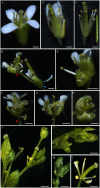SEPALLATA--like genes of Isatis indigotica can affect the architecture of the inflorescences and the development of the floral organs
- PMID: 35251790
- PMCID: PMC8896020
- DOI: 10.7717/peerj.13034
SEPALLATA--like genes of Isatis indigotica can affect the architecture of the inflorescences and the development of the floral organs
Abstract
Background: The architecture of inflorescence and the development of floral organs can influence the yield of seeds and have a significant impact on plant propagation. E-class floral homeotic MADS-box genes exhibit important roles in regulation of floral transition and differentiation of floral organs. Woad (Isatis indigotica) possesses unique inflorescence, floral organs and fruit. However, very little research has been carried out to determine the function of MADS-box genes in this medicinal cruciferous plant species.
Results: SEPALLATA orthologs in I. indigotica were cloned by degenerate PCR. The sequence possessing the highest identity with SEP2 and SEP4 of Arabidopsis were named as IiSEP2 and IiSEP4, respectively. Constitutive expression of IiSEP2 in Columbia (Col-0) ecotype of Arabidopsis led to early flowering, and the number of the flowers and the lateral branches was reduced, indicating an alteration in architecture of the inflorescences. Moreover, the number of the floral organs was declined, the sepals were turned into carpelloid tissues bearing stigmatic papillae and ovules, and secondary flower could be produced in apetalous terminal flowers. In 35S::IiSEP4-GFP transgenic Arabidopsis plants in Landsberg erecta (Ler) genetic background, the number of the floral organs was decreased, sepals were converted into curly carpelloid structures, accompanied by generation of ovules. Simultaneously, the size of petals, stamens and siliques was diminished. In 35S::IiSEP4-GFP transgenic plants of apetalous ap1 cal double mutant in Ler genetic background, the cauliflower phenotype was attenuated significantly, and the petal formation could be rescued. Occasionally, chimeric organs composed of petaloid and sepaloid tissues, or petaloid and stamineous tissues, were produced in IiSEP4 transgenic plants of apl cal double mutant. It suggested that overexpression of IiSEP4 could restore the capacity in petal differentiation. Silencing of IiSEP4 by Virus-Induced Gene Silencing (VIGS) can delay the flowering time, and reduce the number and size of the floral organs in woad flowers.
Conclusion: All the results showed that SEPALLATA-like genes could influence the architecture of the inflorescence and the determinacy of the floral meristems, and was also related to development of the floral organs.
Keywords: Arabidopsis thaliana; Floral homeotic conversion; Floral meristem determinacy; Floral organ differentiation; Floral transition; Inflorescence architecture; Isatis indigotica Fortune; Overexpression; Petal rescue; SEPALLATA-like genes.
© 2022 Ma et al.
Conflict of interest statement
The authors declare that they have no competing interests.
Figures








Similar articles
-
Cloning of a SEPALLATA4-like gene (IiSEP4) in Isatis indigotica Fortune and characterization of its function in Arabidopsis thaliana.Plant Physiol Biochem. 2020 Sep;154:229-237. doi: 10.1016/j.plaphy.2020.05.031. Epub 2020 Jun 10. Plant Physiol Biochem. 2020. PMID: 32563851
-
IiSVP of Isatis indigotica can reduce the size and repress the development of floral organs.Plant Cell Rep. 2023 Mar;42(3):561-574. doi: 10.1007/s00299-023-02977-z. Epub 2023 Jan 7. Plant Cell Rep. 2023. PMID: 36609767
-
A SEPALLATA1-like gene of Isatis indigotica Fort. regulates flowering time and specifies floral organs.Gene. 2019 Sep 10;713:143974. doi: 10.1016/j.gene.2019.143974. Epub 2019 Jul 10. Gene. 2019. PMID: 31301484
-
Reproductive meristem fates in Gerbera.J Exp Bot. 2006;57(13):3445-55. doi: 10.1093/jxb/erl181. Epub 2006 Oct 5. J Exp Bot. 2006. PMID: 17023564 Review.
-
Grass meristems II: inflorescence architecture, flower development and meristem fate.Plant Cell Physiol. 2013 Mar;54(3):313-24. doi: 10.1093/pcp/pct016. Epub 2013 Jan 31. Plant Cell Physiol. 2013. PMID: 23378448 Review.
Cited by
-
Expression Characterization of ABCDE Class MADS-Box Genes in Brassica rapa with Different Pistil Types.Plants (Basel). 2023 Jun 4;12(11):2218. doi: 10.3390/plants12112218. Plants (Basel). 2023. PMID: 37299197 Free PMC article.
-
Identification of candidate genes associated with double flowers via integrating BSA-seq and RNA-seq in Brassica napus.BMC Genomics. 2024 Aug 24;25(1):799. doi: 10.1186/s12864-024-10708-1. BMC Genomics. 2024. PMID: 39182038 Free PMC article.
-
Mapping and molecular marker development for the BnaSBT gene controlling inflorescence and plant architectures in B. napus.Mol Breed. 2025 Apr 15;45(4):45. doi: 10.1007/s11032-025-01556-2. eCollection 2025 Apr. Mol Breed. 2025. PMID: 40247998
-
The SEPALLATA-like gene HrSEP1 in Hippophae rhamnoides regulates flower development by interacting with other MADS-box subfamily genes.Front Plant Sci. 2025 Jan 29;15:1503346. doi: 10.3389/fpls.2024.1503346. eCollection 2024. Front Plant Sci. 2025. PMID: 39944949 Free PMC article.
-
Characterization of MADS-Box Gene Family in Isatis indigotica and Functional Study of IiAP1 in Regulating Floral Transition and Formation.Plants (Basel). 2025 Jan 4;14(1):129. doi: 10.3390/plants14010129. Plants (Basel). 2025. PMID: 39795389 Free PMC article.
References
-
- Agrawal GK, Abe K, Yamazaki M, Miyao A, Hirochika H. Conservation of the E-function for floral organ identity in rice revealed by the analysis of tissue culture-induced loss-of-function mutants of the OsMADS1 gene. Plant Molecular Biology. 2005;59(1):125–135. doi: 10.1007/s11103-005-2161-y. - DOI - PubMed
Publication types
MeSH terms
Substances
LinkOut - more resources
Full Text Sources

